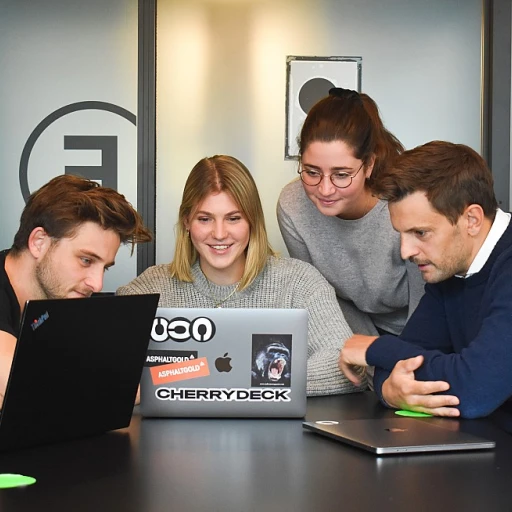Understanding Virtual Reality in Education
Discovering the Potential of Reality Technology in Education
The intersection of technology and education has given rise to new learning possibilities, with virtual reality (VR) and augmented reality (AR) at the forefront. As we navigate this new frontier, it's essential to understand how these immersive technologies are reshaping education. Reality technology, which includes both VR and AR, is revolutionizing the way students engage with content. By providing immersive learning experiences, these technologies transform traditional education into a dynamic, interactive journey.
Virtual environments stand out as a game-changer in education, offering students a chance to experience real-life simulations in a controlled setting. This practical approach not only enhances understanding but also prepares learners for real-world challenges. Especially in subjects like computer science and game design, VR's capacity for offering game-based learning experiences proves invaluable. In the language learning sphere, reality technology offers interactive and engaging content, allowing students to practice in virtual augmented settings.
The variety of experiences enabled by VR and AR doesn't end there. From augmented simulations that provide practical examples to immersive worlds that exploit game mechanics for deeper engagement, the possibilities are vast. These technologies support a language of interactivity that caters to diverse learning needs, making education more inclusive and effective. For those interested in exploring these possibilities further, diving into the
world of virtual learning environments can provide additional insights into how virtual and augmented realities are shaping educational landscapes.
Moreover, the cost-effectiveness of implementing these innovations, combined with their capacity to deliver real-time education virtual experiences, positions reality technology as a viable tool for the future of continuous learning. As we continue to advance in this domain, understanding and leveraging immersive technologies will be crucial in providing enhanced training and educational opportunities.
Benefits of Virtual Reality for Continuous Learning
Advantages of Virtual Reality for Lifelong Learning
The integration of virtual reality in education is paving the way for innovative learning experiences. As technology advances, VR becomes a vital tool in providing more interactive and engaging content that captures the interest of students.
- Immersive Learning Experiences: Virtual reality technology enables learners to explore environments and scenarios that closely mimic real-world situations. This brings education to life, encouraging students to dive into subjects with an unparalleled depth of understanding.
- Enhanced Engagement: With the use of immersive technologies, education becomes more than rote learning. Interactive VR simulations provide opportunities for students to be active participants in their education, thus fostering a higher level of engagement.
- Cost-Effective Training: Implementing VR can be a cost-efficient solution for training. It allows institutions to simulate costly scenarios or environments without the need for physical infrastructure, reducing overall expenses related to logistics and material.
- Augmented Reality for Language Learning: AR complements VR by providing real-time, virtual augmented scenarios that help in language acquisition. This method immerses learners in interactive dialogues and game-based learning that's proven effective in computer science and language classes.
- Bridging the Gap with Frontier Learning: VR opens up new dimensions for education virtual environments that aim to bridge the gap between theory and practice. Students benefit from a hands-on approach, particularly in fields where practical knowledge is crucial, such as science and engineering.
The potential of VR and augmented reality in reshaping learning is substantial. By leveraging these technologies, educators can craft experiences that not only convey knowledge but also foster skills essential for future success. For a more in-depth understanding of how virtual learning environments are revolutionizing education, check out our article on
virtual learning environments.
Challenges in Implementing Virtual Reality
Navigating the Complexity of Implementing VR in Education
Implementing virtual reality (VR) in education holds transformative potential, but it's not without its hurdles. As educational institutions endeavor to integrate VR technology to enrich learning experiences, they encounter several nuanced challenges.
One of the paramount concerns is the cost. Developing and maintaining immersive learning environments with cutting-edge technology can strain budgets, particularly for smaller institutions. The financial commitment involves investing in VR headsets, augmented reality devices, and compatible infrastructure, making it imperative to assess cost-effective solutions tailored to each institution’s unique needs.
Another significant challenge is technological complexity. The intricate nature of virtual environments demands a strong understanding of computer science and game design principles. Educators may require additional training to effectively use and create VR-based learning content. Continuous professional development initiatives can play a pivotal role in ensuring instructors are adept at leveraging VR technology for teaching learning.
Content creation also poses a challenge. Designing interactive and immersive experiences that genuinely augment reality education is time-intensive. It necessitates collaboration between educators and content creators to ensure that virtual augmented experiences align with curricular goals and pedagogical strategies.
Moreover, the variability in language support across VR applications can impede its widespread use in diverse learning environments. As the volition for multilingual and language learning experiences grows, developers must prioritize creating inclusive content that caters to a wider range of students.
The adoption of VR also raises logistical concerns regarding classroom management and student engagement. Educators must balance between virtual interactions and real-world socialization to maintain a holistic learning experience. Practical tips for educators are crucial in this aspect, helping them to tailor VR experiences to benefit students without overwhelming them.
Lastly, connectivity and real-time data processing capabilities remain areas needing enhancement. Ensuring that immersive technologies function seamlessly within existing educational frameworks is vital for realizing their full potential.
To delve deeper into how cutting-edge tools like VR can effectively engage students, explore this
article on enhancing student engagement with cutting-edge tools. Such insights can guide educators in tackling these challenges head-on and paving the way for the future of learning.
Case Studies: Success Stories in VR Education
Real-World Examples: How VR is Transforming Classrooms
In recent years, the integration of virtual reality technology in education has resulted in remarkable achievements across the globe. These case studies highlight the transformative potential of VR in facilitating immersive learning experiences and underscore its effectiveness in various educational contexts.
One notable example comes from a language learning initiative where students engage with virtual environments to practice and enhance their language skills. By navigating scenarios that mimic real-world interactions, students can improve their fluency and comprehension more effectively than traditional methods. The immersive nature of VR prompts genuine engagement, promoting natural language use within a supportive context.
In the realm of science, VR has proven invaluable. Students can conduct complex experiments in a virtual lab without the limitations of physical resources or safety concerns. This approach provides a cost-effective and risk-free platform for experimentation, fostering a deeper understanding of complex concepts.
In social sciences and history, virtual reality enables students to "travel" back in time or explore different cultures. By providing vivid, interactive experiences, VR makes abstract concepts more tangible and helps students retain information more effectively.
Additionally, augmented reality is making headway in creating enriched training programs. For example, in vocational training and technical education, AR-based systems merge real and virtual elements, allowing trainees to practice skills in a controlled, interactive environment.
These successes demonstrate the vast potential of immersive technologies in education. As virtual reality becomes more prevalent, these examples serve as inspiration for future applications that could reshape how education is delivered and experienced worldwide.
Future Trends in Virtual Reality and Education
A Look Ahead: What's on the Horizon
The integration of virtual reality into education is still in its infancy, with promising advancements on the horizon. As developers continue to explore the potential of immersive technologies, we can anticipate significant transformations in how learning experiences are crafted and delivered. Here are some trends that could shape the future of education:
- Augmented Reality (AR) Enhancements: AR is poised to become a game-changer, enhancing real-world learning environments by overlaying digital information in real time. This technology will aid in creating interactive and engaging content that allows students to learn in a more dynamic and intuitive way.
- Cost-Effective Solutions: As the cost of VR equipment continues to decrease, the accessibility of these technologies will improve. Schools and educational institutions will be more likely to adopt virtual and augmented reality tools as part of their standard curriculum, broadening the scope of immersive learning.
- Interactive Language Learning: Virtual reality offers unique opportunities for language learning by immersing students in virtual environments where they can practice and improve their skills with native speakers or AI-based characters.
- Integration with Game Design: The use of gamified platforms and reality-based gaming in education is expected to grow. These platforms leverage the principles of game design to create engaging and rewarding learning experiences that motivate students to advance through the curriculum.
- Advancements in Computer Science: With further developments in computer science and reality-based learning technologies, educators will have access to more sophisticated tools for developing tailored, student-focused learning modules that cater to diverse learning needs.
As schools and educators prepare for this new frontier, staying abreast of these emerging trends will be crucial. Beyond just implementing VR technologies, there will be a focus on creating fully immersive reality education experiences that are adaptable, inclusive, and capable of meeting the educational demands of the future.
Practical Tips for Educators
Implementing Effective Strategies for Educators
To successfully integrate virtual reality into education, educators must adopt practical strategies that leverage the potential of immersive technologies. Here are key approaches:
- Start Small and Scale Up: Initial implementation should begin with pilot programs focused on specific subjects or learning experiences. This allows educators to gauge the effectiveness and make adjustments before full-scale adoption.
- Curriculum Integration: Virtual reality should align with existing curriculum standards. Educators need to ensure that VR experiences enhance traditional learning outcomes and provide clear educational value.
- Professional Development: Teachers require thorough training to effectively utilize VR tools. Continuous professional development opportunities will help educators stay updated on the latest advancements and best practices in immersive learning.
- Focus on Accessibility: It is vital to ensure all students have equal access to VR resources. Schools should consider cost-effective solutions and equitable access when planning their VR strategies.
- Collaborate with Experts: Partnering with game design and computer science professionals can help create tailored VR experiences that are both educational and engaging. This collaboration can provide insights into the technical aspects and pedagogical approaches that maximize interactive and immersive learning.
- Evaluate and Reflect: Regular assessment of VR-based learning experiences is necessary to measure progress and effectiveness. Educators should gather feedback from students to refine and improve VR content delivery.
- Incorporate Multilingual Support: For language learning, VR and augmented reality can provide real-time, interactive language immersion. Educators should use VR tools that offer multilingual support to cater to diverse student populations.
By adopting these strategies, educators will be better positioned to harness the power of reality technology, providing students with a frontier learning experience that is as immersive as it is educational. Successful implementation will pave the way toward a technologically rich future in reality education.













